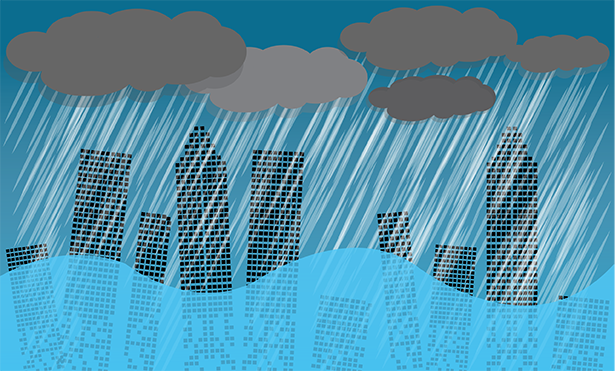 The hurricanes that hit the United States over the last few months have left the insurance industry facing piles of claims. Commercial insurance buyers have enjoyed a soft market in recent years, but this fall's catastrophe losses are likely to result in higher prices going forward, at least for buyers with catastrophe exposures.
The hurricanes that hit the United States over the last few months have left the insurance industry facing piles of claims. Commercial insurance buyers have enjoyed a soft market in recent years, but this fall's catastrophe losses are likely to result in higher prices going forward, at least for buyers with catastrophe exposures.
Some estimates of insurers' losses related to the recent natural disasters have been sky-high. Fitch Ratings said that catastrophe losses for 2017, including those related to the three hurricanes—Harvey, Irma, and Maria—and the earthquakes in Mexico, will cost global insurers and reinsurers more than $100 billion and could get up to $190 billion.
Steven Weisbart, senior vice president and economist at the Insurance Information Institute, noted that insurance companies are still receiving and processing claims from the hurricanes. It could take until November or December to get a good handle on the costs, he said.
Gary Marchitello, head of property broking at Willis Towers Watson, pointed out in an email that the widely varying estimates of the losses related to the three hurricanes have “created great uncertainty for insurers/reinsurers in estimating their losses/posting reserves and formulating their ongoing pricing strategy.”
While the losses are hefty, insurers and reinsurers are sitting on plenty of cash.
Don Griffin, a vice president at the Property Casualty Insurers Association of America, noted that at the end of the second quarter, U.S. insurance companies' capital and surplus totaled an all-time high of $717 billion, while the global reinsurance industry's capital exceeded $605 billion. “So not only do we have a lot of cash available in the U.S., it's available worldwide,” he said.
Moreover, Griffin said, some of the losses caused by Hurricane Harvey will be covered by the National Flood Insurance Program, rather than private insurers, and about half of the losses that resulted from Hurricane Irma were covered by reinsurance.
“We may see an uptick in commercial rates,” Griffin said. “Having said that, I don't know that it will be as significant as many might think.”
Return on Insurers' Capital
 Duncan Ellis, U.S. property practice leader at insurance brokerage Marsh, agreed that the losses were likely to represent a small portion of insurers' capital. He said consensus puts the recent losses at about $100 billion, in addition to about $16 billion from other catastrophes earlier in the year.
Duncan Ellis, U.S. property practice leader at insurance brokerage Marsh, agreed that the losses were likely to represent a small portion of insurers' capital. He said consensus puts the recent losses at about $100 billion, in addition to about $16 billion from other catastrophes earlier in the year.
“This $100 billion loss is going to remove about 14% of the capital and surplus of the insurance market,” Ellis said. “That's $100 billion being taken out of $700 billion.”
He expects the cost of insurance to increase, but said that would reflect not the loss of capital but insurers' unhappiness with the amount they're earning on their capital.
“The prices have become so low that the return on that capital was pretty mediocre. With these losses, the return on that capital is very poor,” Ellis said. “Insurance companies are looking to raise prices, especially in the natural catastrophe space, to get a return on that capital.”
Prices might not increase across the board. Owners of properties exposed to natural catastrophes, like “those along the Gulf Coast, those in wind-prone areas like Central Florida, I think they are going to see increases in pricing on those properties that are exposed,” he said.
Those whose properties are not exposed to catastrophes may not see price increases, Ellis said, but they “may no longer see declines.”
“The pricing increases we're going to see are going to be differentiated by risk,” he summed up. While some accounts could renew at a flat rate, “other accounts that are cat-risk-exposed are going see some significant uplift. If some of those cat-risk-exposed accounts also see losses, I would say they would be looking at some type of adjustment.”
Willis Towers Watson's Marchitello also expects to see price increases.
“The commercial insurance marketplace has been very stable so far,” he said. “We do, however, expect a change in the marketplace after insurers have a chance to estimate their ultimate losses. We fully expect to see some type of market correction.”
Marchitello said, though, that the “upward rate movement” might not occur until the first or second quarter of 2018. And he sees the possibility of developments that offset that price move.
“For example, more capital could come into the marketplace,” he said. “There are some providers of alternative capital with dry powder on the sidelines waiting for something like this.”
The Insurance Information Institute's Weisbart said the string of hurricanes in the United States this fall has upset expectations about future weather events.
“There is once again a debate, not just in insurance circles but elsewhere, about whether the three major hurricanes we've had in a very short span represent a model for the future or a freak,” he said. “It's obviously a big difference not only in terms of how lives should be led, but how insurance companies arrange their business model.”
Insurance rates going forward will reflect not just past claims, but insurers' expectations for future claims, Weisbart added.
“Some of it will be dependent on: Do underwriters and actuaries think we're going to have more years like 2017? Or are they going to take the position that this was a freak year, and we'll have more years like 2013, 2014, 2015, where we had very few catastrophes?” he said. “Which one they do will go a long way toward telling us which way rates will change, if they change.”
© 2025 ALM Global, LLC, All Rights Reserved. Request academic re-use from www.copyright.com. All other uses, submit a request to [email protected]. For more information visit Asset & Logo Licensing.



